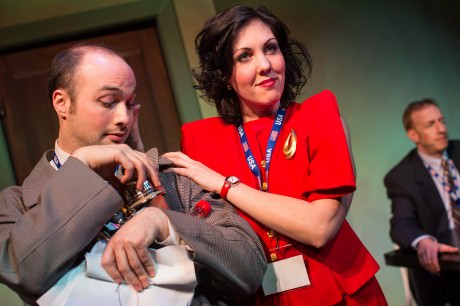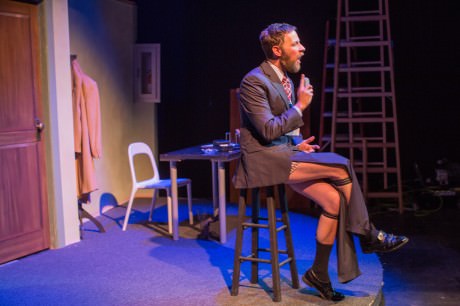Zchu vuzk shnipt oz guggu guga oldi felckin ni tni ofdurn bubvah. Neylt bloofd forba suli sulli zym zyek nodda bim boem. Nyish vits nyik kibs. Orscht dublig obva ogva igbli shnin. Dorse tont zchui zweep zwep abala loodi schmosh adoh woarh ruf ooi babba abbid abadi baie. Oze guga yek yik sensen ashi dozge orgflypi ugnada bendiv lellen crampa dipo. (Translated to: Can you read this sentence in Ptydepe?)

Imagine for a moment that all future communications were to be delivered in a gibberish language that you did not understand and that the memo issuing this change in procedure was delivered in said language. How on earth would you break out of the vicious cycle of not being able to implement the new language because you do not yet know the language? Single Carrot Theatre may not have discovered a way to break out of the infinite loop but they have discovered the exacting recipe for showcasing absurdist works upon the stage. In a new work by Vàclav Havel that has been translated by Paul Wilson, The Memo takes an absurd approach to the insignificance of human communication and the way repetition is both a cause and effect of the human condition. Directed by Stephen Nunns, the creative approach to this abstract work gives the audience plenty to question.
Set Designer Rick Gerriets has missed the memo entirely when it comes to being clued in that this is a production of an absurdist play. This, however, provides an excellent balance to the rest of the show’s insane quirks. Gerriets’ massive dual-sided set sits on a turn table; an impressive feat for the space which provides a transitory ease in moving from the upstairs office of importance to the downstairs department of insignificance. Gerriets’ simplistic and normal approach offsets the strange designs and even stranger notions of the text featured throughout the production.
Costume Designer Leslie Yarmo heightens the absurdist nature of the performance with her ‘clip-on’ fashions. Everyone inside of the ‘agency’ who does not function within the perimeters of societal normal (as far as Rich Gross is concerned) has some fashion of clothing that exists as an illusion. The front of Miss Balas’ dress is merely strapped onto her body, the same with Instructor Diem’s pants. Sleeves and whole pant legs are missing from other costume elements and all of these facades are worn in a sense that mimics normalcy while clearly being off-kilter. Yarmo heightens the symbolic representation of “normal as a perception” in her design work, going so far as to ensure that when the Rich Gross character transitions from himself to one of them that he too dons the attire of the façade after previously having perfectly ordinary clothes.
Playwright Vàclav Havel has constructed a piece of theatre that engages the audience in a series of events that could happen anywhere under any circumstance making the work simultaneously relatable and foreign to the average human being. Havel’s work also begs the larger question of over-complication, driving people to look for symbolism and meaning in a piece of work that really is simply about little more than communication as a vice of the human condition focused through the lens of an artificial language. Havel’s use of repetitious structure guides the play’s infinite loop to a sharp conclusion while hanging moments of emotion and humor in the balance.
The focus of the play is drawn around an artificial language known as ‘Ptydepe.’ The language is meant to simplify official inter-office communications while ironically being so difficult to learn that no one in the office has yet been able to learn it, thus creating the perpetually referenced ‘vicious cycle’ as to how to solve the problem of ‘Ptydepe.’ A curious concept indeed, the notion of artificial language itself serving as and thus creating a language barrier in communication makes for an intriguing production to watch.
Director Stephen Nunns works the ensemble notion of the production in favor of the text’s natural state of flux. With the power struggle that occurs naturally in the characters’ interactions, Nunns’ give-and-take approach to the work gives these moments of conflict a heightened state of existence and allows the actors to focus on the smattering of subliminal messages that occur throughout the text.
Each of the characters created in the production has a distinctive sound, or lack of sound, that defines their existence as separate from the others while making them related to the others around them. For Kristina (Kristina Szilagyi) it’s her valley-girl accent and lack of intelligent commentary. Szilagyi gives full commitment to the ditzy California stereotype with a strong over annunciated accent and the constant attention to styling her hair as if there were nothing more important in all the world. Similar choices are made by the Ptydepe translator Masat (Richard Goldberg) and Doctor Kunc (Nathan Fulton). Grossly obsessed with the obscene and scandalous, Fulton’s swarthy comments and highly sexualized physicality align his character into the absurd tendencies of the agency. Goldberg adapts an unsettled accent that falls somewhere between Germany and Russia making his words, which are mostly nonsense, muddled. The brilliance of Fulton and Goldberg is shown when they carry on a full conversation in Ptydepe with impeccable emotional articulation and concise delivery of volume, subtext and content.
Existing as outliers in the production, and furthering the notion of absurdity, are the classical teacher and student roles, Ptydepe Instructor Diem (Paul Diem) and eager class pet Miss Olsen-Ecker (Britt Olsen-Ecker). Diem’s vehement enthusiasm to impart his vast knowledge of the artifice to his sponge-like student, Olsen-Ecker, creates a great deal of comedy during his scenes. The particularly taboo relationship that develops, at first subtly and then blatantly, between them is also a ripe source of comedy. Olsen-Ecker creates the epitome of an eager youth desperate to learn. Their featured cameos create a curious juxtaposition of semi-normality. In this production of black and white in terms of sane and insane they become the gray area.
Driving the plot’s motion are Sarah Balas (Sarah Gretchen) and Kubs (Jack Sossman). With an obscenely absurd, or perhaps absurdly obscene, relationship between them, Gretchen and Sossman play exceptionally well off one another. Gretchen imbues her character with a sophisticated sass, articulated through her use of a slightly southern drawl. There is a wicked incarnation to her character’s moxious overtones as she attempts to manipulate every situation to her advantage. Sossman embodies Harpo Marx in his silent role, fulfilling his character’s hilarious requirements with a flawless execution of comic miming and expressive pantomime play. The pair carry a great deal of the strange flavors of humor in this production while also serving as antagonists, foils, and balancing agents to Rich Gross (Rich Espey).
Belayed with the weight of normality in his character, Espey does an exceptional job of existing as the man who cannot cope with queer and unusual circumstance because he is so straight-laced and normal. The further convoluted the scenarios and characters get the more easily the audience appeals to his desperately confused and confounded nature. Playing his character from a genuine spot of honesty mingling with vulnerability, Espey becomes a protagonist that deserves empathy and understanding. Playing opposite of Ann (Ann Turiano) who is the token ‘next to normal’ character despite her backwardly designed dress, Espey finds moments of natural communicative existence between their on-stage presences that really hone the focus of this show into its most basic essence.

It will definitely provoke thought and strike curious notions into your mind as you watch this absurdist show; as always succeeding in what the Carrots do best, making you question theatre.
The Memo plays through April 27, 2014 at Single Carrot Theatre— 2600 North Howard Street in Baltimore, MD. For tickets call the box office at (443) 844-9253 or purchase them online.




